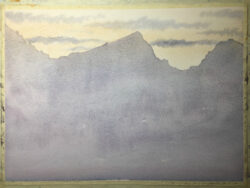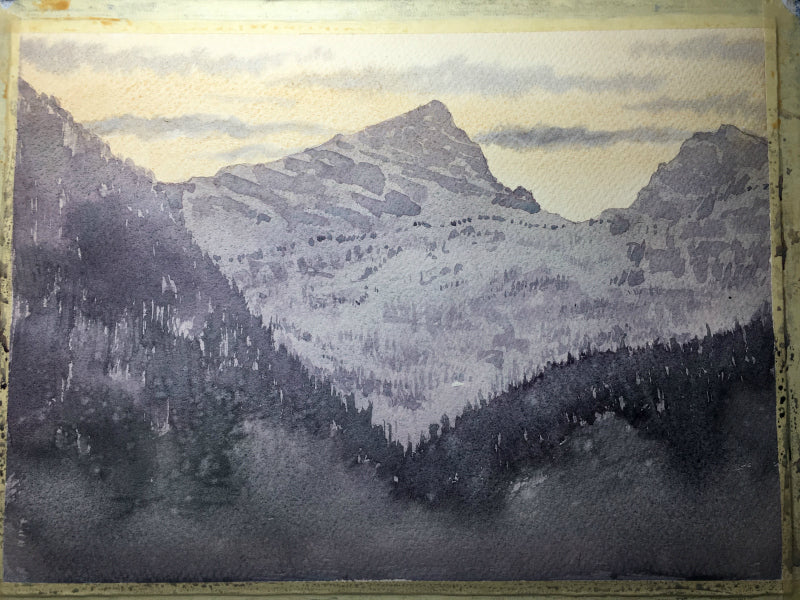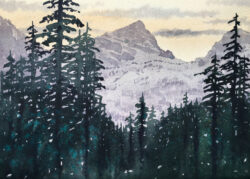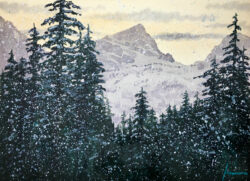Step by Step Winter Mountain Watercolor Landscape | Ian de Hoog
December 28, 2020Moonglow Extra Fine Watercolor by DANIEL SMITH is an amazing three-pigment blend. Watch with anticipation as Anthraquinoid Red floats, Ultramarine Blue settles and Viridian grays result in soft violet colour. Selectively blot and lift as well as wash to expose delicate blue-greens.
In this article Canadian watercolourist and instructor Ian de Hoog gives a step-by-step guide to painting with these amazing watercolours.
Painting mountain landscapes can be daunting. Where to start, what colours, how much detail, which brush, the list can go on and on. In this article I will take a winter mountain scene and break it down into easily approachable steps, so we can cover washes, developing layers, and even a few special effects.
I grew up on the west coast and have always been drawn to the landscapes of the Pacific Northwest. The Vancouver Island Ranges were just a couple of hours’ drive and home to Mount Washington ski resort. I have fond memories of going skiing up there on family trips both as a kid with my parents and later as a parent with kids of my own. Early morning light, soft shadows on the jagged mountainside, and a light snowfall provided by some incoming clouds create a peaceful winter palette that I’ll try to recreate here.
Over the last few years, I have worked hard to minimize the steps I use to make my watercolour paintings. I tend to get very detail-oriented and that wound up in very tight paintings I was generally not happy with. Keeping the steps to a minimum has helped reduce the temptation to go back in with my brush and working and reworking areas. This has also helped produce fresher looking washes since the paints are left alone and given a chance to do their thing.

Step 1, winter watercolor landscape
Step 1
Starting with the lightest washes I began this painting with the sky. Using clean water and a large brush I wet the base of the mountain tops. Turning the support upside down I applied a wet wash of French Ochre just below the area I brushed with clear water and I work the yellow up into the moistened area. I then reload the brush and work down from the initial area of yellow to the top (actually the bottom) of the painting.
For the clouds, I add some water to Lavender until it was a nice thick creamy texture. I darkened it with a touch of Moonglow and while the sky still had some sheen to it, I scrubbed in the Lavender mixture to form the clouds and left to dry completely. TIP – Keeping the paint mixture thick and creamy helps it to stay put on the wet sky wash. The clouds will still soften, but it won’t spill out all over the place. Also, try using a cut-up fan brush to put in the clouds. Brush the colour in quickly and then LEAVE IT ALONE. Resist the temptation to go back and work the clouds.

Step 2, winter watercolor landscape
Step 2
For the base wash on the mountains, I mixed up a very light wash of Moonglow and worked from the mountain tops down to the bottom. It is important to mix up a very large batch of your colour so you have enough to cover the entire area. Having said that, I will still add a little more pigment or water here and there to vary things up a little, so I don’t end up with a completely flat wash. This helps build some implied texture for the snow. Again, this is left to dry completely.

Step 3, winter watercolor landscape
Step 3
Building with another layer of Moonglow that is only slightly darker than the previous wash I quickly add the texture of the rocky mountain face as well as some of the tree textures on the distant hills. I added just a hint of Perylene Green to this wash and working left to right create the mid-ground treeline, working it all the way down to the bottom. While the wash is still wet, I used a fan brush to splatter in a little clean water to break the wash up a little and once again I leave the whole painting to dry completely.

Step 4, winter watercolor landscape
Step 4
For my first pass on the foreground trees, I mix up a large batch of Perylene Green with a bit of Cascade Green. I use a very large rigger brush and start with the tallest peaks, working each peak concurrently and I progress from top to bottom. This forces me to work quickly and keep my brushstrokes loose and free. Once the wash has reached the bottom and is still wet, I quickly drag in some thick Neutral Tint to form tree trunks, and then I splatter in some thick Cobalt Teal Blue that helps to break the wash up a little by adding some texture and also helping to lighten the wash a bit and this is left to dry.

Step 5, final. “Snowfall” by Ian de Hoog. 14.5×10.5 inches
Step 5
For the final touches, I reused the dark wash from the previous step and add more depth to the foreground trees. Once this has dried, I mixed up some thick Chinese White and spatter that on in successive layers to create the feeling of a light snowfall. While this is drying I lightly painted in some snow on the trees not intending it to stand out, but to dry just slightly lighter than the trees and add some additional texture.
Before I even added a brushstroke I had my main trio of colours picked out. Rather than think about colours from a primary triad point of view, I will generally think 1 (light), 2 (middle), and 3 (dark) and use these to help develop the tone in my painting. For this painting, I chose French Ochre as my light, Moonglow, and my middle, and Perylene Green as my dark.
#1. French Ochre lovely earth yellow that is not only perfect for conveying morning light, but it also provides some lovely granulation on the rough paper I used for this painting.
#2. Moonglow is a very versatile mixture that I felt would be perfect for the mountain washes and also stay transparent enough for the French Ochre to come through in the mountain tops. When left to develop, the colours that make up Moonglow will also settle into the grooves of the rough paper reveal different colour variances throughout the wash.
#3. Perylene Green has been a go-to dark for me for some time. In this painting, it really helped send the foreground trees right to the front.
DANIEL SMITH Colors used in this painting
French Ochre
Moonglow
Perylene Green
Cobalt Teal Blue
Lavender
Neutral Tint
Cascade Green
Chinese White
“I love that Daniel Smith believes that the control should be in the hands of the artist. As a result, they use nothing in their paints to modify the way the paint would “naturally” behave. This approach, matched with consistent quality in every tube, assures me that whenever I mix my colours, I get consistent results every time. Combine that philosophy with a strong effort to support established artists and help develop new artists and you have a winner in my books. Oh, and did I mention that they have an unparalleled selection of colours to choose from? Over the years these additional colours have provided me an opportunity to explore and develop my artistic voice.” – Ian de Hoog
 DANIEL SMITH Paints on my palette
DANIEL SMITH Paints on my palette
Hansa Yellow Medium
Quinacridone Gold
Organic Vermilion
Quinacridone Lilac
Pyrrol Crimson
Cerulean Blue Chromium
Phthalo Blue GS
Ultramarine Blue
Green Gold
Phthalo Green BS
Cobalt Violet
Moonglow
French Ochre
Burnt Sienna
Deep Scarlet
German Greenish Raw Umber
Cobalt Teal Blue
Neutral Tint
Ian de Hoog’s watercolor palette

Artist Bio
Ian de Hoog is a Canadian watercolourist and instructor living out on the West Coast of British Columbia. Ian developed an early visual interest in the medium due to the works of Franklin Carmichael and Toni Onley. However, it was during a brief stint studying architecture that a physical love of painting manifested. While primarily self-taught, Ian is very grateful for the recent opportunities he has had to study with Thomas Schaller and Herman Pekel.
“Having grown up in the Pacific Northwest it is the elements of this region that I continue to return to in my work. At some point or another, I have been in all the places that I paint whether it was during my time as a professional photographer, or in more recent years as a painter. I love revisiting places I once photographed in a new light and even more so I love standing in new places with my easel before me. My work is a re-creation of things I see, things I remember and often a reflection of how I am feeling.” – Ian de Hoog
Ian’s paintings have been exhibited in solo and group exhibitions and are included in a growing number of private collections around the world.
Website: IandeHoog.com
Ian’s demos and workshops
Instagram: @iandehoogart
Facebook: IandeHoogArt
Twitter: IandeHoogArtist

